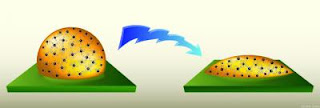The manipulation of small volumes of liquid is critical for fluidic digital display devices, optical devices, and microelectromechanical systems (MEMS) such as lab-on-chip analysis systems. Most research into such systems has been conducted with regular liquids, but not nanofluids, which are liquids embedded with different nanoparticles. Nanofluids have been shown to exhibit some attractive properties, including enhanced heat transfer and capillary properties, as compared with regular, or pure, liquids.
Borca-Tasciuc’s team placed droplets of water-based solutions containing bismuth telluride nanoparticles onto a Teflon-coated silicon wafer. When an electric field was applied to the droplet, the researchers observed a strong change in the angle at which the droplet contacted the wafer. This change was much higher than that observed in liquids without the nanoparticles when tested under the same conditions.
“You use the same electrical field, but you get more change in shape with the nanofluid. We know the nanoparticles are critical in this process because without them the effect is much less strong,” Borca-Tasciuc said.
The ability to easily change the contact angle of droplets of nanofluids has potential applications for efficiently moving liquids in microsystems, creating new methods of focusing lenses in miniature cameras, or cooling computer chips. Borca-Tasciuc also envisions the research enabling new fully integrated micro- and nanoscale heat transfer systems that will not require a pump. “Our proof of concept really opens up many new exciting possibilities,” he said.
Borca-Tasciuc said his investigations into nanofluids are driven by sheer curiosity, and fostered by a strong interdisciplinary collaboration with Rensselaer Materials Science and Engineering Professor Ganapathiraman Ramanath.
“At first, we were curious to see what would happen if we introduced charged nanostructures – such as the ones we synthesize for exploring new cooling strategies in nanodevices – to the process of liquid wetting. But what started as a single, one-off experiment has now mushroomed into an exciting new research topic and expanded the scope of our collaboration,” Ramanath said ###
The research article, titled “Electrowetting on dielectric-actuation of microdroplets of aqueous bismuth telluride nanoparticle suspensions,” was published in a recent issue of the journal Nanotechnology.
Along with Borca-Tasciuc and Ramanath, co-authors of the paper include Rensselaer post-doctoral research associate Arup Purkayastha, and graduate student Raj K. Dash.
The research was funded in part by the National Science Foundation and the New York State Foundation for Science, Technology and Innovation through the Interconnect Focus Center.
About Rensselaer
Rensselaer Polytechnic Institute, founded in 1824, is the nation’s oldest technological university. The university offers bachelor’s, master’s, and doctoral degrees in engineering, the sciences, information technology, architecture, management, and the humanities and social sciences. Institute programs serve undergraduates, graduate students, and working professionals around the world.
Rensselaer faculty are known for pre-eminence in research conducted in a wide range of fields, with particular emphasis in biotechnology, nanotechnology, information technology, and the media arts and technology. The Institute is well known for its success in the transfer of technology from the laboratory to the marketplace so that new discoveries and inventions benefit human life, protect the environment, and strengthen economic development.
Contact: Michael Mullaney mullam@rpi.edu 518-276-6161 Rensselaer Polytechnic Institute
Tags: Nano or Nanotechnology and Nanotech or Rensselaer Polytechnic Institute and Nanofluid or microelectromechanical systems















No comments:
Post a Comment